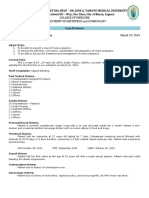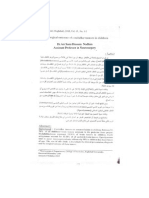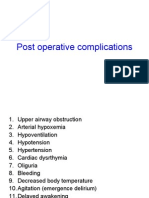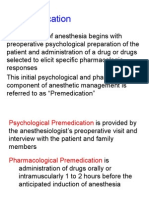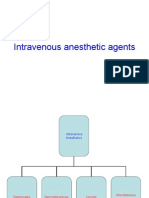0 ratings0% found this document useful (0 votes)
239 viewsLiver Haemangioma Resection
Liver Haemangioma Resection
Uploaded by
drhiwaomerSadia Ahmed 23 years old female from Chamchamal / Suleimania / Kurdistan Government Iraq. Presented with hematemesis and malena to Shorish military hospital. Recurrent in nature, moderate in amount. Receiving over all 12 pints of blood in a course of one month. Many times scoped in Baghdad and undiagnosed.
US revealed 5 cm echogenic lesion, round shape in the right lobe of the liver, deeply seated. At the time of admission she was shocked, rapid circulatory support has performed by blood transfusion and then scoped which revealed hemobilia. The procedure took 35 min.
PCV 22%
WBC 8000/ml
ESR 60mm/hr.
GUE inconclusive
BU 55 mg/dl
Serum amylase not available.
Electrolyte, cid base and blood gas not available.
Coagulation profile was not available apart from bleeding and clotting time both of which were normal.
Liver function shows mild increase in TSB 3mg/dl and mildly raised Alkaline phosphatase 17 KAU
Angiography was not available. And the CT has not been done because of the unstability of the patient's condition.
Blood group A+
Chest XR and ECG were normal .
No other investigation were available in that small hospital in hard days of
Saddam's Erra. Exploration was urgent and done by Kokher incision the bile duct has been seen dilated with greenish color. It has been explored and the blood was evacuated . Pringles maneuvers has been applied and follys catheter ball has been used to localize the site of the bleeding as the first case and the lesion has been located in the upper biliary tree. Segmental resection of the segment 6 of the liver was done depending on palpation of the firm lesion. The biliary tree has been cleaned and the duct has been closed on T- tube. She had uneventful recovery.
Discharged 10 days later. After 3 weeks of the initial surgery she had the same presentation of upper GIT bleeding, the scope again revealed hemobilia. She has been explored again after resuscitation and the firmness was extending to the wider area of the right lobe involving segment 5. The blood was coming from both ducts even after repeated wash out. Longitudinal gauze pack has been inserted repeatedly to both ducts, the result was not very conclusive because both biliary tree were full of blood and it was difficult to clear them completely. It made us in a mess. We has been obliged to do right hepatic lobectomy by thoraco-abdominal incision due to difficulties in the area made by the previous surgery.
There was no way to locate the source except by palpation. Which revealed indurations in the right lobe with almost normal consistency of the left lobe. On this base of the operative decision was right hepatic lobectomy. Fortunately she had uneventful recovery and the histopathology was consitent mostly with amoebic liver abscesse.
Date of Admission 5/9/2001
Date of Discharge 15/9/2001.
Copyright:
Attribution Non-Commercial (BY-NC)
Available Formats
Download as PDF or read online from Scribd
Liver Haemangioma Resection
Liver Haemangioma Resection
Uploaded by
drhiwaomer0 ratings0% found this document useful (0 votes)
239 views38 pagesSadia Ahmed 23 years old female from Chamchamal / Suleimania / Kurdistan Government Iraq. Presented with hematemesis and malena to Shorish military hospital. Recurrent in nature, moderate in amount. Receiving over all 12 pints of blood in a course of one month. Many times scoped in Baghdad and undiagnosed.
US revealed 5 cm echogenic lesion, round shape in the right lobe of the liver, deeply seated. At the time of admission she was shocked, rapid circulatory support has performed by blood transfusion and then scoped which revealed hemobilia. The procedure took 35 min.
PCV 22%
WBC 8000/ml
ESR 60mm/hr.
GUE inconclusive
BU 55 mg/dl
Serum amylase not available.
Electrolyte, cid base and blood gas not available.
Coagulation profile was not available apart from bleeding and clotting time both of which were normal.
Liver function shows mild increase in TSB 3mg/dl and mildly raised Alkaline phosphatase 17 KAU
Angiography was not available. And the CT has not been done because of the unstability of the patient's condition.
Blood group A+
Chest XR and ECG were normal .
No other investigation were available in that small hospital in hard days of
Saddam's Erra. Exploration was urgent and done by Kokher incision the bile duct has been seen dilated with greenish color. It has been explored and the blood was evacuated . Pringles maneuvers has been applied and follys catheter ball has been used to localize the site of the bleeding as the first case and the lesion has been located in the upper biliary tree. Segmental resection of the segment 6 of the liver was done depending on palpation of the firm lesion. The biliary tree has been cleaned and the duct has been closed on T- tube. She had uneventful recovery.
Discharged 10 days later. After 3 weeks of the initial surgery she had the same presentation of upper GIT bleeding, the scope again revealed hemobilia. She has been explored again after resuscitation and the firmness was extending to the wider area of the right lobe involving segment 5. The blood was coming from both ducts even after repeated wash out. Longitudinal gauze pack has been inserted repeatedly to both ducts, the result was not very conclusive because both biliary tree were full of blood and it was difficult to clear them completely. It made us in a mess. We has been obliged to do right hepatic lobectomy by thoraco-abdominal incision due to difficulties in the area made by the previous surgery.
There was no way to locate the source except by palpation. Which revealed indurations in the right lobe with almost normal consistency of the left lobe. On this base of the operative decision was right hepatic lobectomy. Fortunately she had uneventful recovery and the histopathology was consitent mostly with amoebic liver abscesse.
Date of Admission 5/9/2001
Date of Discharge 15/9/2001.
Copyright
© Attribution Non-Commercial (BY-NC)
Available Formats
PDF or read online from Scribd
Share this document
Did you find this document useful?
Is this content inappropriate?
Sadia Ahmed 23 years old female from Chamchamal / Suleimania / Kurdistan Government Iraq. Presented with hematemesis and malena to Shorish military hospital. Recurrent in nature, moderate in amount. Receiving over all 12 pints of blood in a course of one month. Many times scoped in Baghdad and undiagnosed.
US revealed 5 cm echogenic lesion, round shape in the right lobe of the liver, deeply seated. At the time of admission she was shocked, rapid circulatory support has performed by blood transfusion and then scoped which revealed hemobilia. The procedure took 35 min.
PCV 22%
WBC 8000/ml
ESR 60mm/hr.
GUE inconclusive
BU 55 mg/dl
Serum amylase not available.
Electrolyte, cid base and blood gas not available.
Coagulation profile was not available apart from bleeding and clotting time both of which were normal.
Liver function shows mild increase in TSB 3mg/dl and mildly raised Alkaline phosphatase 17 KAU
Angiography was not available. And the CT has not been done because of the unstability of the patient's condition.
Blood group A+
Chest XR and ECG were normal .
No other investigation were available in that small hospital in hard days of
Saddam's Erra. Exploration was urgent and done by Kokher incision the bile duct has been seen dilated with greenish color. It has been explored and the blood was evacuated . Pringles maneuvers has been applied and follys catheter ball has been used to localize the site of the bleeding as the first case and the lesion has been located in the upper biliary tree. Segmental resection of the segment 6 of the liver was done depending on palpation of the firm lesion. The biliary tree has been cleaned and the duct has been closed on T- tube. She had uneventful recovery.
Discharged 10 days later. After 3 weeks of the initial surgery she had the same presentation of upper GIT bleeding, the scope again revealed hemobilia. She has been explored again after resuscitation and the firmness was extending to the wider area of the right lobe involving segment 5. The blood was coming from both ducts even after repeated wash out. Longitudinal gauze pack has been inserted repeatedly to both ducts, the result was not very conclusive because both biliary tree were full of blood and it was difficult to clear them completely. It made us in a mess. We has been obliged to do right hepatic lobectomy by thoraco-abdominal incision due to difficulties in the area made by the previous surgery.
There was no way to locate the source except by palpation. Which revealed indurations in the right lobe with almost normal consistency of the left lobe. On this base of the operative decision was right hepatic lobectomy. Fortunately she had uneventful recovery and the histopathology was consitent mostly with amoebic liver abscesse.
Date of Admission 5/9/2001
Date of Discharge 15/9/2001.
Copyright:
Attribution Non-Commercial (BY-NC)
Available Formats
Download as PDF or read online from Scribd
Download as pdf
0 ratings0% found this document useful (0 votes)
239 views38 pagesLiver Haemangioma Resection
Liver Haemangioma Resection
Uploaded by
drhiwaomerSadia Ahmed 23 years old female from Chamchamal / Suleimania / Kurdistan Government Iraq. Presented with hematemesis and malena to Shorish military hospital. Recurrent in nature, moderate in amount. Receiving over all 12 pints of blood in a course of one month. Many times scoped in Baghdad and undiagnosed.
US revealed 5 cm echogenic lesion, round shape in the right lobe of the liver, deeply seated. At the time of admission she was shocked, rapid circulatory support has performed by blood transfusion and then scoped which revealed hemobilia. The procedure took 35 min.
PCV 22%
WBC 8000/ml
ESR 60mm/hr.
GUE inconclusive
BU 55 mg/dl
Serum amylase not available.
Electrolyte, cid base and blood gas not available.
Coagulation profile was not available apart from bleeding and clotting time both of which were normal.
Liver function shows mild increase in TSB 3mg/dl and mildly raised Alkaline phosphatase 17 KAU
Angiography was not available. And the CT has not been done because of the unstability of the patient's condition.
Blood group A+
Chest XR and ECG were normal .
No other investigation were available in that small hospital in hard days of
Saddam's Erra. Exploration was urgent and done by Kokher incision the bile duct has been seen dilated with greenish color. It has been explored and the blood was evacuated . Pringles maneuvers has been applied and follys catheter ball has been used to localize the site of the bleeding as the first case and the lesion has been located in the upper biliary tree. Segmental resection of the segment 6 of the liver was done depending on palpation of the firm lesion. The biliary tree has been cleaned and the duct has been closed on T- tube. She had uneventful recovery.
Discharged 10 days later. After 3 weeks of the initial surgery she had the same presentation of upper GIT bleeding, the scope again revealed hemobilia. She has been explored again after resuscitation and the firmness was extending to the wider area of the right lobe involving segment 5. The blood was coming from both ducts even after repeated wash out. Longitudinal gauze pack has been inserted repeatedly to both ducts, the result was not very conclusive because both biliary tree were full of blood and it was difficult to clear them completely. It made us in a mess. We has been obliged to do right hepatic lobectomy by thoraco-abdominal incision due to difficulties in the area made by the previous surgery.
There was no way to locate the source except by palpation. Which revealed indurations in the right lobe with almost normal consistency of the left lobe. On this base of the operative decision was right hepatic lobectomy. Fortunately she had uneventful recovery and the histopathology was consitent mostly with amoebic liver abscesse.
Date of Admission 5/9/2001
Date of Discharge 15/9/2001.
Copyright:
Attribution Non-Commercial (BY-NC)
Available Formats
Download as PDF or read online from Scribd
Download as pdf
You are on page 1of 38
Provisional diagnoses –
huge haemangioma of the liver in
an infant
Dr. Qalander Kasnazani
Consultant surgeon
Areen Star, Eight month old female, date: 17/5/2006,
Shorish hospital. Kurdistan. Sulaimani
Areen star, eight month old female. Presented with huge abdominal
distention and refused to take milk properly. Blood count and blood film
and biochemical study was raising the diagnose of iron deficiency
anaemia and imagine revealed huge haemangioma of the liver.
Exploration has been done after correction of very low hemoglobine and
extensive liver reception has been done for entire left lobe of the liver by
roof top incision. She had un-eventful recovery the histopathology was
in favour of haemangiosarcoma. There was no extra hepatic
involvement or any invasion or metastatic lymph nodes in the resected
specimen. She did well after surgery and follow up is continuing with her.
30 years old female ,presented with upper abdominal pain, sever and
constant,interferes with life style of the patient ,the main findings was a big upper
abdominal mass which was tender and firm .moves with respirations she was pale and
had pain on her expression during the exam. Previosly operated for livar mass which
has been left without interferance.and the abdomen was immediately closed.
Upper abdominal ultra has revealed big haemangioma of the liver which has been
proved by M R I .SHE HAD HER Hb of 9 gm per del.
Her liver function was all normal.and so all other investigations.
The mass was involving most of her right lobe keepin the left lobe free of any
involvement. Right hemi hepatectomy has been performed for her and she had un
eventful recovery .
The slides has been provided as follows:
You might also like
- English-Kurdish - Arabic Medical DictionaryDocument110 pagesEnglish-Kurdish - Arabic Medical Dictionarydrhiwaomer80% (15)
- Surgery Blue QuestionsDocument25 pagesSurgery Blue QuestionsJamie ElmawiehNo ratings yet
- GI Case Studies-StudentDocument7 pagesGI Case Studies-StudentRhina FutrellNo ratings yet
- Gastroenterology Medical Records SampleDocument1 pageGastroenterology Medical Records SampleMarisol Jane JomayaNo ratings yet
- Case Study Colon CancerDocument8 pagesCase Study Colon CancerVecky Tolentino80% (5)
- Cholecystitis - Discharge SummaryDocument1 pageCholecystitis - Discharge SummaryIndranil SinhaNo ratings yet
- Welcome To Clinical PresentationDocument37 pagesWelcome To Clinical PresentationIAMSANWAR019170No ratings yet
- EMQsDocument30 pagesEMQsnob2011nob100% (1)
- Gastroenterology MEDTRANS SAMPLEDocument1 pageGastroenterology MEDTRANS SAMPLEMarisol Jane JomayaNo ratings yet
- Nama: Mayasari Lingga Kelas: 2.1 PSIK NIM: 150206072Document3 pagesNama: Mayasari Lingga Kelas: 2.1 PSIK NIM: 150206072Maya Sari LinggaNo ratings yet
- 2012 Complete Board Questions PDFDocument43 pages2012 Complete Board Questions PDFbmhsh100% (1)
- CA Pancreas BasirDocument9 pagesCA Pancreas BasirwhosenahNo ratings yet
- Hepatoblastoma ResectionDocument21 pagesHepatoblastoma ResectiondrhiwaomerNo ratings yet
- Higado Graso y Embarazo PDFDocument4 pagesHigado Graso y Embarazo PDFSebastian Hernandez MejiaNo ratings yet
- Abd Pain 2019Document66 pagesAbd Pain 2019mohammed alrubaiaanNo ratings yet
- Case Presentation Endometriosis 1Document15 pagesCase Presentation Endometriosis 1Muhammad Ahmad Syammakh0% (1)
- GastroenterologyDocument30 pagesGastroenterologyMohammad MohyeddienNo ratings yet
- Status EBCR Pak SartoDocument10 pagesStatus EBCR Pak Sartoemilina cornainNo ratings yet
- APPENDICITISDocument8 pagesAPPENDICITISJuan Carlos SaguyodNo ratings yet
- FINAL Report #5Document2 pagesFINAL Report #5vizcaynoericka540No ratings yet
- IntussusceptionDocument33 pagesIntussusceptionNovendi RizkaNo ratings yet
- Clinical Case Preentation On Ovarian TumorDocument14 pagesClinical Case Preentation On Ovarian TumordrtasmiaakterNo ratings yet
- Major Case Study NDDocument10 pagesMajor Case Study NDapi-313165458No ratings yet
- A 64 Years Old Woman, Complained Abdominal Pain, Unexplained Weight Loss, and Ileo-Caecal FistulaDocument11 pagesA 64 Years Old Woman, Complained Abdominal Pain, Unexplained Weight Loss, and Ileo-Caecal FistulagunNo ratings yet
- Short CasesDocument102 pagesShort CasesAanandi Arun MagotraNo ratings yet
- Nutrition Issues in GastroenterologyDocument10 pagesNutrition Issues in GastroenterologyjinniNo ratings yet
- Corrected Presentation by DR - JabinDocument57 pagesCorrected Presentation by DR - JabinSagor Kumar DasNo ratings yet
- Volvulus of The ColonDocument14 pagesVolvulus of The ColondrhiwaomerNo ratings yet
- ANAEMIADocument9 pagesANAEMIAAiman ArifinNo ratings yet
- 2 PLACENTA PREVIA Case PresentationDocument19 pages2 PLACENTA PREVIA Case PresentationAiswarya ThomasNo ratings yet
- Uterine FibroidsDocument11 pagesUterine FibroidsBenjamin Kusi-AppiahNo ratings yet
- Case SceneriosDocument108 pagesCase Sceneriosdr.aliceNo ratings yet
- Soal Bedah Dasar 22 2 23Document32 pagesSoal Bedah Dasar 22 2 239gps6jw28bNo ratings yet
- Kasai Procedure in The Management of Biliary AtresiaDocument7 pagesKasai Procedure in The Management of Biliary Atresiamutiara cita raselyNo ratings yet
- Case PresDocument56 pagesCase PresHardiTariqHammaNo ratings yet
- SurgeryDocument12 pagesSurgeryManusheeNo ratings yet
- Git 2Document18 pagesGit 2Mateen ShukriNo ratings yet
- GOO Due To DUDocument29 pagesGOO Due To DUtamzidshafi78No ratings yet
- Case Report Hepato FinalDocument29 pagesCase Report Hepato FinalBangkit PutrawanNo ratings yet
- Case Protocol OB - H MOLEDocument3 pagesCase Protocol OB - H MOLEKim Adarem Joy ManimtimNo ratings yet
- Bowel Obstruction: Abdulqader Taha Almuallim, MBBS General Surgery ResudentDocument19 pagesBowel Obstruction: Abdulqader Taha Almuallim, MBBS General Surgery ResudentMuathNo ratings yet
- 264Document4 pages264limey78460No ratings yet
- Postgrad Med J 2005 Yalamarthi 174 7Document5 pagesPostgrad Med J 2005 Yalamarthi 174 7Novendi RizkaNo ratings yet
- Summary of The Pertinent Information of The Case:: ST NDDocument2 pagesSummary of The Pertinent Information of The Case:: ST NDCarissa RodenasNo ratings yet
- SFSFDocument1 pageSFSFGovind Narayan PandeyNo ratings yet
- Mq Surgery 1920Document7 pagesMq Surgery 1920Fadhlina OmarNo ratings yet
- Case Write Up Medicine-Palliative CareDocument11 pagesCase Write Up Medicine-Palliative CareRoshandiep GillNo ratings yet
- CKD 21 2 147Document5 pagesCKD 21 2 147Sinbijeo GinNo ratings yet
- 1Document1 page1mdniazNo ratings yet
- Surgical Case NCPDocument2 pagesSurgical Case NCPMaryjoy Gabriellee De La CruzNo ratings yet
- Pancreas QuestionDocument7 pagesPancreas QuestionRumana Ali100% (1)
- Case Report:: TH TH THDocument6 pagesCase Report:: TH TH THzzNo ratings yet
- Gastric Outlet ObstructionDocument42 pagesGastric Outlet ObstructionSouvikNo ratings yet
- Suci TmboDocument15 pagesSuci TmboyongkyNo ratings yet
- Precocious Puberty ProtocolDocument7 pagesPrecocious Puberty ProtocolLaiza DonesNo ratings yet
- Open Cholecystectomy: By: Santoyo, Sarah Jane R. BSN 3-B Group 6-Operating RoomDocument6 pagesOpen Cholecystectomy: By: Santoyo, Sarah Jane R. BSN 3-B Group 6-Operating RoomJullie Anne SantoyoNo ratings yet
- ca colonDocument41 pagesca colonmusaibrahim7411No ratings yet
- Upper Gastro Intestinal BleedingDocument11 pagesUpper Gastro Intestinal BleedingSyima MnnNo ratings yet
- Autoimmune PeritonitisDocument1 pageAutoimmune PeritonitiskaranlehaNo ratings yet
- Long Case Clinical Pathology.747Document6 pagesLong Case Clinical Pathology.747Marwa SamehNo ratings yet
- Thyroid& ParathyroidDocument98 pagesThyroid& Parathyroiddrhiwaomer100% (12)
- Laparoscopy AtlasDocument199 pagesLaparoscopy Atlasdrhiwaomer100% (2)
- Indications in SrgeryDocument73 pagesIndications in Srgerydrhiwaomer100% (4)
- Day Case Surgery 1LDocument21 pagesDay Case Surgery 1LdrhiwaomerNo ratings yet
- Laparoscopic Tubal SterilizationDocument8 pagesLaparoscopic Tubal SterilizationdrhiwaomerNo ratings yet
- GlaiyDocument1 pageGlaiydrhiwaomerNo ratings yet
- Hepatoblastoma ResectionDocument21 pagesHepatoblastoma ResectiondrhiwaomerNo ratings yet
- Laparoscopic Tubal SterilizationDocument8 pagesLaparoscopic Tubal SterilizationdrhiwaomerNo ratings yet
- Surgical Outcome of Cerebellar Tumors in ChildrenDocument10 pagesSurgical Outcome of Cerebellar Tumors in ChildrendrhiwaomerNo ratings yet
- ژوان Kurdish Short storyDocument2 pagesژوان Kurdish Short storydrhiwaomerNo ratings yet
- Diagnostic LaparosDocument8 pagesDiagnostic Laparosdrhiwaomer100% (3)
- Laparoscopic Management of Ectopic PregnancyDocument7 pagesLaparoscopic Management of Ectopic Pregnancydrhiwaomer100% (3)
- CV DR Ari Sami 2008Document4 pagesCV DR Ari Sami 2008drhiwaomer100% (2)
- Post Operative ComplicationsDocument17 pagesPost Operative Complicationsdrhiwaomer100% (8)
- Indications and Contraindications of Laparoscopy1Document18 pagesIndications and Contraindications of Laparoscopy1drhiwaomer100% (2)
- Kurdish / Arabic/englsh Medical DictionaryDocument82 pagesKurdish / Arabic/englsh Medical Dictionarydrhiwaomer89% (9)
- Inhalational AgentsDocument12 pagesInhalational Agentsdrhiwaomer100% (1)
- PremedicationDocument9 pagesPremedicationdrhiwaomer100% (3)
- Anesthesia Lecture 3Document25 pagesAnesthesia Lecture 3drhiwaomer100% (2)
- Intravenous Anesthetic AgentsDocument23 pagesIntravenous Anesthetic Agentsdrhiwaomer100% (7)
- Anesthesia Lecture 3Document25 pagesAnesthesia Lecture 3drhiwaomer100% (2)
- High Output Renal FailureDocument4 pagesHigh Output Renal Failuredrhiwaomer100% (1)
- Metastatized Colonic CancerDocument17 pagesMetastatized Colonic Cancerdrhiwaomer100% (3)
- Anesthesia Lecture 1Document16 pagesAnesthesia Lecture 1drhiwaomer100% (9)








































